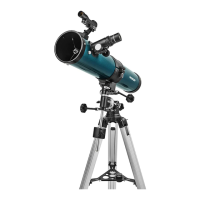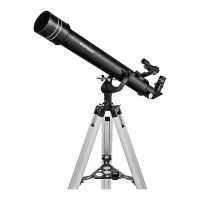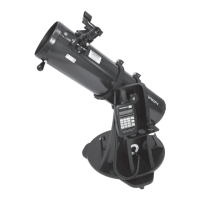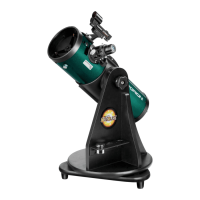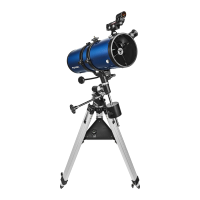15
ror should appear in the very center of the out-of-focus circle,
like the hole in a donut. If the “hole” appears off-center, the
telescope is out of collimation. If you try the star test and the
bright star you have selected is not accurately centered in
the eyepiece, the optics will always appear out of collimation,
even though they may be perfectly aligned. It is critical to keep
the star centered, so over time you will need to make slight
corrections to the telescope’s position in order to account for
the sky’s apparent motion.
8. Telescope Care and
Maintenance
If you give your telescope reasonable care, it will last a life-
time. Store it in a clean, dry, dust free place, safe from rapid
changes in temperature and humidity. Do not store the tele-
scope outdoors, although storage in a garage or shed is OK.
Small components like eyepieces and other accessories
should be kept in a protective box or storage case. Keep the
caps on the front of the telescope and on the focuser draw-
tube when not in use.
Your SpaceProbe II 76mm EQ telescope requires very little
mechanical maintenance. The optical tube is steel and has
a smooth painted nish that is fairly scratch resistant. If a
scratch does appear, it will not harm the telescope.
Cleaning Optics
You should not have to clean the telescope’s mirrors. Covering
the telescope with the dust cap when it is not in use will help pre-
vent dust from accumulating on the mirrors. Even a little dust on
the mirror surfaces will not affect the optical performance in any
way. If you feel the mirrors need to be cleaned, please contact
Orion Customer Service at 800-676-1343 for guidance.
To clean the eyepiece lenses, any quality optical lens clean-
ing tissue and optical lens cleaning uid specically designed
for multi-coated optics can be used. Never use regular glass
cleaner or cleaning uid designed for eyeglasses. Before clean-
ing, remove any loose particles or dust from the lens with a
blower bulb or soft brush. Then apply some cleaning uid to a
tissue, never directly on the optics. Wipe the lens gently in a cir-
cular motion, then remove any excess uid with a fresh lens tis-
sue. Oily ngerprints and smudges may be removed using this
method. Use caution; rubbing too hard may scratch the lens. On
larger lenses, clean only a small area at a time, using a fresh
lens tissue on each area. Never reuse tissues.
When bringing the telescope inside after an evening’s viewing
it is normal for moisture to accumulate on the lenses due to the
change in temperature. We suggest leaving the telescope and
eyepieces uncovered overnight to allow the condensation to
evaporate.
9. Specifications
Optical tube material: Rolled steel
Primary mirror diameter: 76mm (3.0")
Primary mirror coating: Aluminum with silicon dioxide
(SiO2) overcoat
Secondary mirror minor axis dia.: 19.9mm
Focal length: 700mm
Focal ratio: f/9.2
Focuser: Rack-and-pinion, accepts 1.25" accessories
Eyepieces: 25mm and 10mm Kellner, antireection coated,
1.25" barrel diameter, threaded for Orion lters
Eyepiece magnication: 28x (with 25mm eyepiece) and 70x
(with 10mm eyepiece)
Finder scope: Red dot nder scope
Mount: German equatorial
Tripod: Aluminum
Motor drive: Optional
Total instrument weight: 11 lbs., 11 oz.
Figure 25.
A star test will determine if the telescope's optics are
properly collimated.
Figure 26. The Kellner eyepieces have barrels threaded to
accept optional Orion 1.25” lters. A Moon lter is useful for cutting
glare and revealing more detail on the lunar surface.
Out of collimation Collimated

